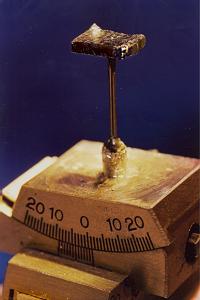Current Research
-
Magnetism in low dimensional systems.
Fundamental research into the nature of magnetism in low dimensional systems can reveal a fascinating range of properties including novel magnetic behaviour. Technologically applicable research is studied, for example in superconducting / ferromagnetic layers, aiming to explain the magnetic nature of interfacial correlations. Magnetism in bulk systems which show magnetism confined to a plane or a 1-D chain is also studied.
-
Magnetism in bulk superconducting systems.
The coexistence of magnetism and superconductivity is a massively active area of research in condensed matter. In particular in systems where ferromagnetism not only coexists with superconductivity but indeed seems to be essential for the mediation of Cooper pairs.
-
Fermi surface measurements in novel phases.
The sensitivity of Compton scattering to bands crossing the Fermi level allows for Fermi surface features to be observed. This sensitivity in conjunction with reconstruction techniques allow for 2-D Fermi surfaces to be recovered from 1-D momentum projections and one can identify hole/electron pockets and other features such as nesting vectors.
-
Magnetism in lanthanide and actinide compounds.
Magnetism in 4f and 5f compounds often show interesting and often complex phase diagram, with many novel states shown to exist. As such, interest in these systems have seen a revival in recent years. The discovery of superconductivity and ferromagentism in UGe2 albeit at high pressure then at abient pressures in UCoGe has revealed the fascinting consequences of these systems.
-
Spin polarisation and spin moments in half-metallic systems.
Research into "spintronic" materials hopes to produce devices which rely on the spin of an electron instead of the charge. Current aims are in creating materials which can inject electrons consisting of only one spin polarisation. We study materials which are promising candidates for possessing 100 % spin polrisation at the Fermi level. Where the spin polarisation is defined as:



